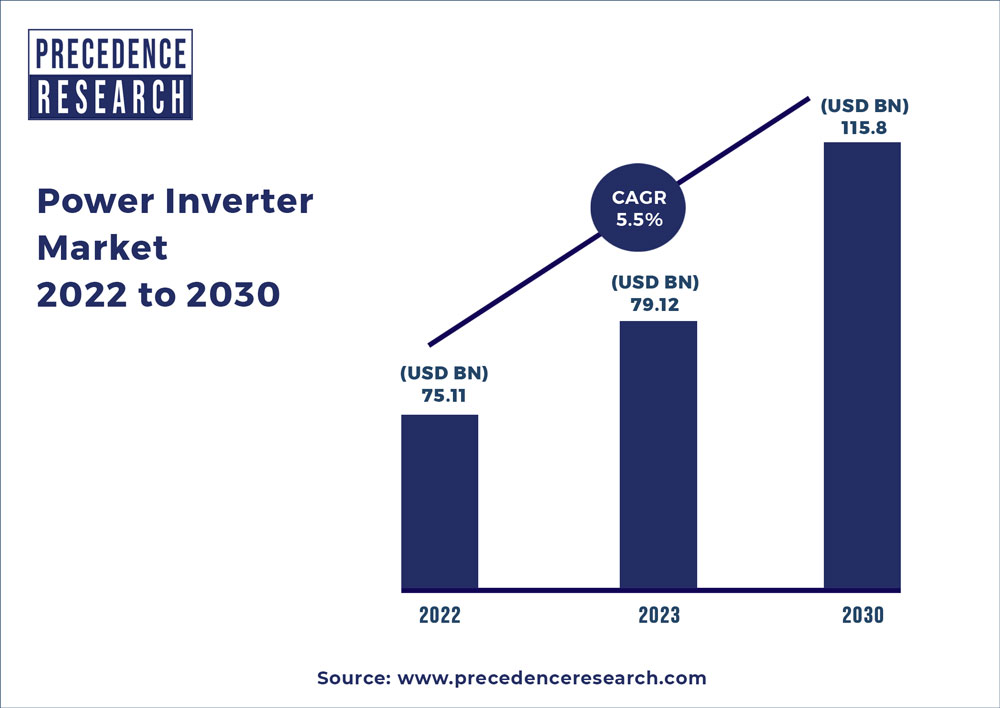Power Inverter Market Size, Trends, Growth, Report 2030
The global power inverter market size accounted for USD 75.11 billion in 2022 and is expected to hit around USD 115.8 billion by 2030, growing at a CAGR of 5.5% during the forecast period from 2022 to 2030.

The demand for power inverters is growing at a significant rate owing to the rising government investments in the industrialization, urbanization, and electrification of rural areas. The growing demand for delicate consumer electronics across the globe has boosted the necessity of protecting it from the damages caused by power fluctuations. The rising awareness among consumers regarding environmental protection is supplementing the growth of solar PVs and EVs/HEVs power inverters across the globe. The increasing number of residential projects in developing and underdeveloped regions is significantly driving the growth of the global power inverter market. The rising dependence of people on a wider variety of electric appliances and products is further boosting the growth of the power inverter market. Furthermore, the various developmental strategies adopted by the market players such as partnerships, acquisitions, and mergers is expected to drive the growth of the market. The rising investments in the research and development of the power inverter to enhance its operational efficiency is spurring the demand for power inverters across the globe.
Power Inverter Market Report Scope
| Report Coverage | Details |
| Market Size In 2022 | USD 75.11 Billion |
| Market Size By 2030 | USD 115.8 Billion |
| Growth Rate from 2022 to 2030 |
CAGR of 5.5% |
| Base Year | 2021 |
| Forecast Period | 2022 to 2030 |
| Segments Covered |
|
| Regions Covered |
|
Report Highlights
Based on the end user, the commercial segment is estimated to be the most opportunistic segment during the forecast period. This is attributed to the rising penetration of various commercial spaces like shopping malls, gyms, cafes, and various other units in developing and underdeveloped nations across the globe.
Based on the application, EVs/HEVs are estimated to be the fastest-growing segment during the forecast period. This is attributable to the rising demand for electric vehicles among the global population owing to the regulatory framework of the government that encourages the adoption of such eco-friendly commuting solutions.
Regional Snapshot
Asia Pacific is the most dominant power inverter market and is estimated to be the fastest-growing market during the forecast period. Asia Pacific is characterized by rapid industrialization and urbanization along with the rising government expenditure on electrification and the development of infrastructural facilities. These factors are boosting the adoption of advanced power inverters in the region. Moreover, the growing penetration of commercial spaces in the developing areas of the Asia Pacific is estimated to have a positive impact on the growth of the power inverter market. Furthermore, the rising disposable income, improved standards of living, and growing demand for private passenger cars is boosting the demand for electric vehicles in the region. The rapidly growing electric vehicle industry in the region is expected to significantly drive the growth of the Asia Pacific power inverter market in the forthcoming years.
Market Dynamics
Driver: Rapid urbanization and industrialization
The governments in developing markets like India, China, and Brazil are significantly investing in the development of infrastructural facilities, urbanization, industrialization, and electrification of rural areas. The growing developmental activities will significantly foster the growth in the demand for power inverters during the forecast period. The rising demand for various consumer electronics and automotive electric vehicles is further expected to drive the growth of the global power inverter market, owing to the favorable government policies that encourage the growth of the electronics and automotive industries.
Restraint: High costs of power inverters
The high cost associated with power inverters is a major restraining factor that may restrict the growth of the market. The low affordability in underdeveloped countries coupled with the low access to common electronic products among low-income consumers may hinder the growth of the power inverter market during the forecast period.
Opportunity: Rising adoption of the electric vehicles
The rising government initiatives to reduce carbon footprints is giving rise to the adoption of EVs and HEVs across the globe. The rising consciousness among consumers regarding environmental conditions is fueling the adoption of eco-friendly vehicles that use electric power. Therefore, the increasing adoption of HEVs and EVs across the globe is expected to drive the demand for power inverters in the forthcoming future.
Challenge: Lack of electrification
There is a lack of electrification and improper electricity supply in developing and underdeveloped regions. The lack of electricity hampers the demand for the majority of electronic products and also power inverters. Thus, the lack of electricity and power supply is a major threat to the power inverter market.
Key Players in the Report:
- SMA Solar Technology AG
- ABB Ltd.
- Huawei Technologies Co., Ltd.
- Toshiba Mitsubishi-Electric Industrial Systems Corporation (TMEIC)
- Omron Corporation
- Advanced Energy Industries, Inc.
- SolarEdge Technologies Inc.
- Enphase Energy, Inc.
- Tabuchi Electric Co., Ltd.
- Schneider Electric SE
Market Segmentation
By Type
- Less than 5KW
- 5-95 KW
- 100-495 KW
- More than 500 KW
By End Use
- Utility
- Commercial
- Residential
By Application
- Motor Drives
- Rail Traction
- Uninterruptible Power Supply
- EVs/HEVs
- Wind Turbines
- Solar PVs
- Others
Buy this Research Report@ https://www.precedenceresearch.com/checkout/1498
You can place an order or ask any questions, please feel free to contact at sales@precedenceresearch.com | +1 9197 992 333